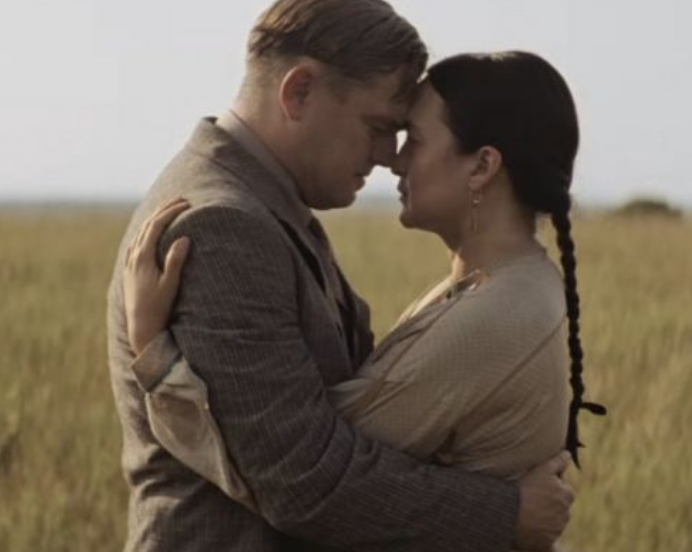
- Details
- By Levi Rickert
Opinion. I missed the opening weekend of the much-ballyhooed Killers of the Flower Moon in October because I was on assignment in Anchorage, covering the Alaska Federation of Natives convention and The Road to Healing tour.
The Road to Healing listening session that Sunday was filled with difficult stories of abuse told by Alaska Native elders. They recounted stories of physical, emotional and sexual abuse.
Later that evening, I got a ride to the airport from Shelly Lowe, chair of the National Endowment for the Humanities, along with a member of her staff. Lowe told me they had seen Killers of the Flower Moon the night before on Saturday evening. She inquired if I had seen it yet.
“No,” I said, “but I may try to see it Monday evening after I return to Michigan.” Shelly warned that I might want to wait a few days. While the trauma depicted in the movie was different from what we heard at the Road to Healing session, she said, there are still gross abuses against Native Americans.
 Make A Donation Here
Make A Donation Here
Having read David Grann’s 2017 non-fiction book Killers of the Flower Moon: The Osage Murders and the Birth of the FBI, I knew the abuses involved white greed and murders of Osage members. I took their advice and delayed seeing the film. It was a busy fall for me. Since Anchorage, I covered two more Road to Healing listening sessions, and went on a business trip to Arizona State University. Then I covered the National Congress of American Indians (NCAI) convention and marketplace in New Orleans. A trip to the movie theater was not going to happen.
Finally, on the Friday after Thanksgiving, I went by myself to see Killers of the Flower Moon in my hometown of Grand Rapids, Michigan.
Co-produced and directed by the award-winning Martin Scorsese, who also co-wrote the script with Eric Roth, the movie proved to be just as disturbing as Shelly’s warning.
The movie unveils the story of the Osage, who, because of oil on their allotted lands in Oklahoma, became some of the world’s wealthiest people on a per capita basis. During the 1920s, dozens of Osage died under mysterious circumstances. In many cases, those circumstances turned out to be murder. The film concentrates on the family of Mollie Burkhart, played by 37-year-old Lily Gladstone (Blackfeet and Nimíipuu), who had several members of her family murdered, including two sisters.
Scorsese relies on two of his go-to Academy Award-winning actors to help tell the story of white greed. Leonardo DiCaprio stars as Mollie’s husband, Ernest Burkhart, and Robert De Niro stars as Burkhart’s uncle, William K. Hale. DiCaprio has previously collaborated with Scorsese in six feature films and De Niro in 10 films.
This comfort level between the director and actors, coupled with the power of their acting talents, diminishes Scorsese’s opportunity to tell more of the Osage side of the story.
However, I give Scorsese credit for casting Gladstone. Her performance is Oscar-worthy. She has a dynamic presence on the screen throughout the film and in scene after scene, I thought to myself: “She represents every Native woman.” She was burdened with so much tragedy, forced to handle the affairs of death, including identifying the body of one of her sisters, and providing care for her elderly mother, played by Tantoo Cardinal (Cree and Métis). Gladstone played the part with so much grace, but the intensity of the look on her face and the powerful eyes exemplified the resiliency and strength of Native women.
Filmed on location where the story happened a century ago and the Osage still live today, Scorsese hired Osage citizens as extras, including some relatives I recognized. This added authenticity to Killers of the Flower Moon.
The film gained praise from the masterful Steven Spielberg, who recently interviewed Scorsese. Detailed in a November 16, 2023 Hollywood Reporter article on the interview, Spielberg told Scorsese, “For me, this is just an exceptional experience, watching your film. You know how I feel about all of your films, but this one stands out in a way that’s so impactful for me. It’s an epic journey, but it’s not a Hollywood epic, for me; it’s a humanitarian epic.”
Unfortunately, watching the film in my hometown proved to be both a disappointing and disgusting experience. During a scene when an Osage woman was shot in the back of the head, some adults in the audience laughed out loud.
As the theater emptied out, I sat and watched the end credits and listened to the musical score by the late, great Robbie Robertson. Tears welled in my eyes because I had just cinematically witnessed yet another epic tragedy against Native Americans — and someone thought it was a funny matter. I was the last person to leave the theater.
After my experience, I am thankful my friends from the National Endowment for the Humanities gave me sound advice about spreading out the time between watching the different types of trauma Native Americans experience.
It is emotionally exhausting to continually confront the trauma our community has endured. Still, the acknowledgement of this pain in federal government listening sessions and Hollywood blockbusters signifies a step toward progress because non-Natives are learning the true history of our country’s treatment of Native peoples. It shouldn’t be our burden, but this uncomfortable visibility is crucial for our journey towards justice and healing.
Thayék gde nwéndëmen - We are all related.
More Stories Like This
The Lie We Keep Telling About Wounded KneeAnother Weapon of Mass Destruction
Colorado cannot heal until it confronts Sand Creek honestly
Native American Mothers Deserve to Live
Technology Rooted in Tradition is Strengthening Cherokee Nation
Help us defend tribal sovereignty.
At Native News Online, our mission is rooted in telling the stories that strengthen sovereignty and uplift Indigenous voices — not just at year’s end, but every single day.
Because of your generosity last year, we were able to keep our reporters on the ground in tribal communities, at national gatherings and in the halls of Congress — covering the issues that matter most to Indian Country: sovereignty, culture, education, health and economic opportunity.
That support sustained us through a tough year in 2025. Now, as we look to the year ahead, we need your help right now to ensure warrior journalism remains strong — reporting that defends tribal sovereignty, amplifies Native truth, and holds power accountable.
 The stakes couldn't be higher. Your support keeps Native voices heard, Native stories told and Native sovereignty defended.
The stakes couldn't be higher. Your support keeps Native voices heard, Native stories told and Native sovereignty defended.
Stand with Warrior Journalism today.
Levi Rickert (Potawatomi), Editor & Publisher

